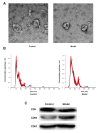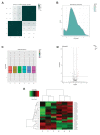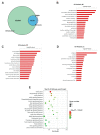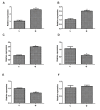Circulating Exosomal MicroRNA Profiles Associated with Acute Soft Tissue Injury
- PMID: 34455724
- PMCID: PMC8405084
- DOI: 10.22074/cellj.2021.7275
Circulating Exosomal MicroRNA Profiles Associated with Acute Soft Tissue Injury
Abstract
Objective: This study aimed to characterize the circulating exosomal microRNA (miRNA) profiles associated with acute soft tissue injury.
Materials and methods: In this experimental study, a total of 12 rats were randomly divided into control group and model group (n=6 for each group). The rats in the model group were used to establish an acute soft tissue injury following the mechanical injury of the leg. The exosomes from the peripheral blood of all the rats were isolated and then characterized by Nanosight NS300 particle size analyser (NTA), transmission electron microscopy (TEM) and western blot. Next, the exosomal miRNAs in the control and model groups were sequenced, and the differentially expressed miRNAs (DE-miRNAs) were identified using the DESeq algorithm. Functional analyses were performed using Gene Ontology (GO) terms and the Kyoto Encyclopedia of Genes and Genomes (KEGG) pathway databases. Finally, quantitative reverse-transcription polymersa chain reaction (qRT-PCR) was used to verify the expression of the DE-miRNAs.
Results: TEM, NTA and western blot results showed that the exosomes were approximately 100 nm in size and exhibited cup-shaped morphology. A total of 628 miRNAs were obtained by sequencing. After that, 28 DE miRNAs (DEmiRNAs) were identified, including seven down-regulated miRNAs and 21 up-regulated miRNAs. These DE-miRNAs were linked to 7539 target genes with GO. Also, KEGG analyses demonstrated that these genes were enriched for phosphorylation, VEGF signaling pathway, and MAPK signaling pathway. Additionally, the consistency rate between the qRT-PCR and sequencing results was 83.33%, which showed a high relative reliability of the sequencing results.
Conclusion: These findings suggest that these 28 exosomal miRNAs may be involved in the regulation of acute soft tissue injury, by one of critical biological processes (BP), phosphorylation. The findings provide valuable clues by utilizing exosomes as therapeutic targets for the effective treatment of acute soft tissue injury.
Keywords: Exosomes; Gene Ontology; MicroRNAs; Sequencing; Soft Tissue Injuries.
Copyright© by Royan Institute. All rights reserved.
Conflict of interest statement
There is no conflict of interest in this study.
Figures





Similar articles
-
Differentially expressed miRNA profiles of serum-derived exosomes in patients with sudden sensorineural hearing loss.Front Neurol. 2023 Jun 2;14:1177988. doi: 10.3389/fneur.2023.1177988. eCollection 2023. Front Neurol. 2023. PMID: 37332997 Free PMC article.
-
Mesenchymal stem cells derived-exosomes as a new therapeutic strategy for acute soft tissue injury.Cell Biochem Funct. 2021 Jan;39(1):107-115. doi: 10.1002/cbf.3570. Epub 2020 Jul 7. Cell Biochem Funct. 2021. PMID: 32638406
-
MicroRNA sequence analysis of plasma exosomes in early Legg-Calvé-Perthes disease.Cell Signal. 2022 Mar;91:110184. doi: 10.1016/j.cellsig.2021.110184. Epub 2021 Nov 2. Cell Signal. 2022. PMID: 34740784
-
Exosomal miRNA-profiling of pleural effusion in lung adenocarcinoma and tuberculosis.Front Surg. 2023 Jan 6;9:1050242. doi: 10.3389/fsurg.2022.1050242. eCollection 2022. Front Surg. 2023. PMID: 36684253 Free PMC article.
-
Differential expression profile of plasma exosomal microRNAs in women with polycystic ovary syndrome.Fertil Steril. 2021 Mar;115(3):782-792. doi: 10.1016/j.fertnstert.2020.08.019. Epub 2020 Oct 9. Fertil Steril. 2021. PMID: 33041053
Cited by
-
Detection and Characterization of Extracellular Vesicles in Sputum Samples of COPD Patients.J Pers Med. 2024 Aug 1;14(8):820. doi: 10.3390/jpm14080820. J Pers Med. 2024. PMID: 39202011 Free PMC article.
-
Effects of urolithin A on osteoclast differentiation induced by receptor activator of nuclear factor-κB ligand via bone morphogenic protein 2.Bioengineered. 2022 Mar;13(3):5064-5078. doi: 10.1080/21655979.2022.2036893. Bioengineered. 2022. PMID: 35164658 Free PMC article.
-
Differentially Expressed microRNAs in Peritoneal Dialysis Effluent-Derived Exosomes from the Patients with Ultrafiltration Failure.Genet Res (Camb). 2022 Aug 31;2022:2276175. doi: 10.1155/2022/2276175. eCollection 2022. Genet Res (Camb). 2022. PMID: 36101746 Free PMC article.
References
-
- Frick MA, Murthy NS. Imaging of the elbow: muscle and tendon injuries. Semin Musculoskelet Radiol. 2010;14(4):430–437. - PubMed
-
- Jeukendrup AE, Vet-Joop K, Sturk A, Stegen JH, Senden J, Saris WH, et al. Relationship between gastro-intestinal complaints and endotoxaemia, cytokine release and the acute-phase reaction during and after a long-distance triathlon in highly trained men. Clin Sci (Lond) 2000;98(1):47–55. - PubMed
LinkOut - more resources
Full Text Sources
